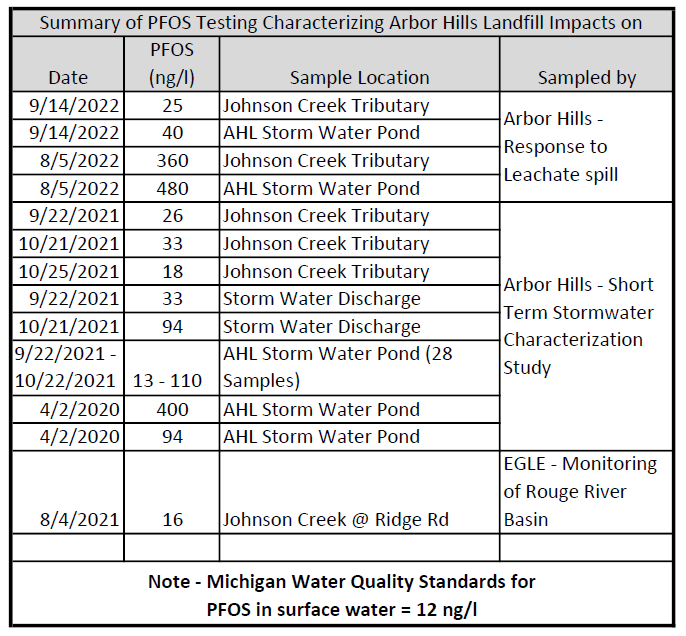The Arbor Hills Landfill is significantly impacting Johnson Creek, and very little is being done to correct the issues. The Stormwater runoff leaving Arbor Hills’ property has contained PFAS[1] contamination above allowable levels since at least 2020. EGLE and Green for Life are aware of the contamination, but little has been done about it. Even more blatant is the impact of the Suspended Solids Arbor Hills discharges into Johnson Creek. Muddy, cloudy, turbid water is discharged to Johnson Creek daily as a result of the poor erosion control practices at Arbor Hills. Suspended solids from soil erosion produce turbid water and lower the dissolved oxygen the creek needs to sustain aquatic life. This blog post will provide details.
Video of turbid water from Arbor HIlls mixing with Johson Creek. Video was taken on July 17, 2024 from the Ridge Road bridge over Johson Creek.
PFAS Discharges
In June 2021, the Arbor Hills Landfill received a violation notice (VN-011821) for discharging PFAS Chemicals in concentrations exceeding Michigan’s water quality standards. This contamination likely resulted from the use of Aqueous Film Forming Foam to combat a fire or from leachate spills and seepage. The violation notice required the landfill owner, Green for Life (GFL), to agree to an Administrative Consent Order to rectify the illegal discharges. However, after 3 years, EGLE has not yet issued the Consent Order.
The Conservancy Initiative began sampling Jackson Creek in 2022 to document and track the issue. EGLE has refused to mandate GFL to perform the sampling, and no actions are being taken to address the PFAS contamination.
PFAS chemicals are known as forever chemicals because they do not break down and live forever. The PFAS in Johnson Creek contaminates fish and eventually finds its way into our food chain.
Our sampling program has detailed a consistent discharge of PFOS at levels exceeding Water Quality Standards. The PFOS results summarized in Table 1 are from The Conservancy Initiative’s sampling program and consistently exceed Michigan’s water quality standards for discharge into surface waters such as Johnson Creek. Table 2 summarizes additional publicly available testing, which characterizes the stormwater runoff. Table 3 shows the consistency of test results for all analyzed PFAS chemicals. Regardless of the precipitation rates near the sampling time, the PFAS concentrations have remained consistent. It was expected that varying precipitation rates could dilute the PFAS concentrations, but this was not the case. A consistent set of PFAS chemicals is regularly detected with similar relative concentrations, indicating that the contamination originates from a single source.
The Conservancy Initiative’s sample results and the testing results from Green for Life document that the Arbor Hills Landfill continues discharging PFOS at levels exceeding allowable limits.
Table 1 - PFOS Concentrations in Arbor Hills Stormwater Runoff
Table 2 - PFOS Results from Testing conducted by Arbor HIlls
Suspended Solids Discharges
Arbor Hills’ impact on Johnson Creek extends beyond PFAS contamination. The landfill also discharges stormwater with high levels of suspended solids, leading to low dissolved oxygen levels in Johnson Creek. These suspended solids, erosion byproducts (sand, dirt, silt, etc.), cause low dissolved oxygen levels. Dissolved oxygen is needed to sustain aquatic life in the creek. EGLE has determined that an 85% reduction in suspended solids is necessary to improve dissolved oxygen levels to meet quality standards for a cold-water stream[2]. Figure 1 and the linked video show the turbidity caused by suspended solids from Arbor Hills mixing with the main artery of Johnson Creek.
On July 10, 2024, a sample from the tributary contained 4,210 mg/L of Total Suspended Solids (TSS), or 0.42% suspended solids. This is an extremely high level of TSS, essentially liquid mud. Arbor Hills discharges hundreds of thousands of gallons into Johnson Creek during a rain event, containing literally tons[3] of suspended solids. The high level of suspended solids in the creek is due to poor erosion control practices at Arbor Hills. It is disappointing that EGLE does not require better erosion control measures, such as covering the mountain with grass.
Figure 1 - Cloudy, turbid water from Arbor Hills Mixes with Johnson Creek (Photo taken on 7/16/24 from the Ridge Road bridge over Johnson Creek
The Conservancy Initiative is frustrated by EGLE's lack of enforcement actions to reduce Arbor Hills's impact on Johnson Creek, but we remain committed to our cause. We strongly believe that prevention is critical. Until actions are taken, we will continue to sample the creek and publish the results to ensure that elected officials fully understand the poor environmental record of Green for Life at Arbor Hills and to prevent any expansion of Arbor Hills.
Table 3 - Detailed test results showing all PFAS chemicals tested. The results are very consistent. Results reported in ng/l. ND = Not Detected
[1] The PFAS acronym refers to a large family of chemicals, Per- and polyfluoroalkyl substances, which are man-made chemicals. These chemicals are commonly referred to using acronyms that include PFOA, PFOS, GenX, and many others. The predominant PFAS contamination found at Arbor Hills is PFOS or Perfluorooctane sulfonate, regulated in Michigan as a water contaminant.
[2] Total Maximum Daily Load for Dissolved Oxygen for Johnson Creek, Michigan Department of Environmental Quality, Water Bureau, [Page 9]
[3] 100,000 gallons of water containing 4310 mg/l TSS would result in 1.6 Tons of solids





